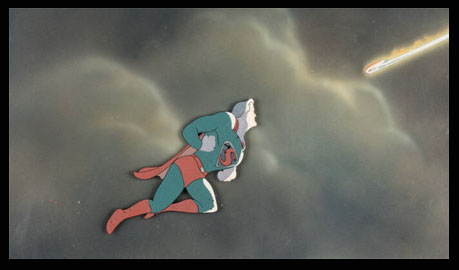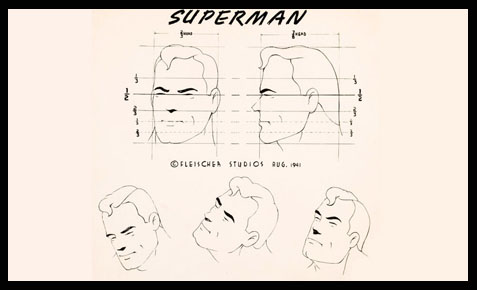
Superman has been in the conversation a lot lately. This spring brought us the highly anticipated Zack Snyder’s Justice League, (which came about thanks to a fan campaign) and this February, the CW network debuted the series, Superman & Lois.
Not surprisingly, as we live in a world of the comic book shared universe TV shows and movies. Before this, each decade and generation seemingly spawned a new version of the DC Comics superhero, from the show Lois & Clark in the ’90s to Christopher Reeve’s iconic films in the 70s and 80s and from Hanna-Barbera’s Superfriends Saturday morning TV show to the very first Superman series, with George Reeves in the 50s. But, when did Superman first appear on screen, large or small? Going back further and further, like we are the Man of Steel himself speeding through time, we would come to, of all places, the animation studio who brought us Betty Boop and Popeye.

The Fleischer Studios first brought Superman to the screen in a series of animated short subjects that debuted in 1941.
Brothers Max and Dave Fleischer were known for the popularity of Betty Boop and Popeye and had also just produced their first full-length feature, Gulliver’s Travels. Paramount Pictures, who distributed their cartoons, approached them about creating a series of cartoon shorts based on the DC comic book hero, Superman, who the studio had secured the rights to the year before.
The Fleischers had moved their animation studio from New York to Miami. They were about to start work on their next feature, Mr. Bug Goes to Town but agreed to produce the Superman shorts at a budget of $100,000 per short (which was approximately four times the budget of their others shorts).
Paramount agreed, and the first of the series was entitled simply Superman and debuted eighty years ago last month on September 26th, 1941.
The short’s budget is all up on the screen. Superman has stunning artistry, particularly for its day. The short begins with the familiar heroic narration: “Up in the sky! Look! It’s a bird! It’s a plane! It’s Superman!” The first to use this now-familiar introduction.

We then receive a very brief “origin story” (told all by narration, in just a few minutes with quick images) of how the planet Krypton exploded, but before it did, it sent one of its own, a child, to earth. The child grew up in an orphanage, but the young boy found himself endowed with incredible powers as years went by. The opening leads into another, now-iconic moment of voice-over: “Faster than a speeding bullet! More powerful than a locomotive! Able to leap tall buildings in a single bound!”
The narrator then informs us that “the infant of Krypton is now the Man of Steel: Superman!” With that, we segue into Superman’s current life as his alter-ego, Clark Kent, a reporter for The Daily Planet newspaper. Clark and intrepid reporter Lois Lane are meeting with their Editor, Perry White.
They learn that there is a mad scientist who has a deadly ray and will strike that night. Lois and Clark are off to capture the story, while Superman will soon be off the capture this villain.
Superman was named one of The 50 Greatest Cartoons in Jerry Beck’s 1994 book of the same name (it came in at 33). it’s easy to see why. The short unfurls a feature-length story, efficiently and compellingly, in a ten-minute time frame.

Directed by Dave Fleischer, the short also uses some beautiful dramatic and atmospheric staging. These include the first shot of The Daily Planet building, from high above the nighttime city, as traffic rushes by on the streets below. Then, there’s the angled images and moody lighting that introduces the mad scientist’s lair.
The character animation is also a wonder to behold. The Fleischer studio used a technique called Rotoscoping utilized in their feature, Gulliver’s Travels. With this, animators would trace drawings over live-action movie footage to add a sense of realism.
However, with the Superman cartoons, the artists didn’t just rely on Rotoscoping. There was also meticulous planning that went into each short, and the animators had to get comfortable drawing more realistic-looking characters and action.
In his seminal 1980 book, Of Mice and Magic: A History of American Animated Cartoons, author Leonard Maltin discussed the artistic challenges of the Superman cartoons with legendary Fleischer animator Myron Waldman:
“Some animators fell right into it,” recalls Waldman, “and others couldn’t do it, they couldn’t draw that well. But we had some very good assistants; they weren’t good animators, but they were good figure men. They would follow-up and clean up these drawings.”
The first Superman cartoon was nominated for an Academy Award for Best Cartoon Short. Seventeen Superman cartoons were produced from 1941 through 1943. Other titles and adventures included The Mechanical Monsters (1941), Electric Earthquake (1942), The Mummy Strikes (1943), and 1942’s Japoteurs, which included World War II propaganda and negative, insensitive stereotypes that were, unfortunately, a part of such cartoons at the time.
The first nine of the Superman shorts were produced by the Fleischers, with the balance of the films produced by Famous Studios after the Fleischer Studio was dissolved in 1942.
The cartoons fell into the public domain through the years, allowing easy access to watch them (as they were usually included in low-priced VHS and DVD compilations). Still, the quality of the films was not always the highest.
There have been some “official” DVD and Blu-ray releases, which allowed for more pristine restorations of the Superman cartoons.
The eightieth anniversary of the first Superman cartoons from the Fleischer studio and the series that followed is a milestone for animation. The artistry and storytelling on display is another example of studios at the time continuing to expand the boundaries of animation.
As professor and author M. Thomas Inge said of the Superman cartoons in Jerry Beck’s 1994 book, The 50 Greatest Cartoons: “The Art Deco settings, the flat character designs and the use of color to create mood combine to elevate the films to a level of pure artistry seldom seen in animation outside of Fantasia the year before.”

- An Eye for A Classic: The 60th Anniversary of “Mr. Magoo’s Christmas Carol” - December 22, 2022
- A Very Merry Mickey: The 70th Anniversary of “Pluto’s Christmas Tree” - December 19, 2022
- A Fine French Feline Film: The 60th Anniversary of “Gay Pur-ee” - December 12, 2022


 October 12th, 2021
October 12th, 2021  Michael Lyons
Michael Lyons  Posted in
Posted in  Tags:
Tags: 






